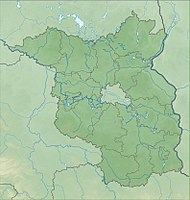Gadsdorfer Torfstiche and Luderbusch nature reserve
|
Gadsdorf peat cuttings and Luderbusch
|
||
|
Gadsdorf peat lake in the nature reserve |
||
| location | Brandenburg , Germany | |
| surface | 138 hectares | |
| WDPA ID | 389594 | |
| Geographical location | 52 ° 12 ' N , 13 ° 20' E | |
|
|
||
| Setup date | September 30, 2009 | |
The nature reserve Gadsdorfer Torfstiche and Luderbusch is a nature reserve that lies on the boundaries of Gadsdorf (municipality of Am Mellensee ) and Christinendorf (town of Trebbin ) in the district of Teltow-Fläming ( Brandenburg ). It covers 138 hectares and was established in 2009.
location
The nature reserve is located in the north-western part of the municipality of Am Mellensee, on the Gadsdorf district and a very small part of it extends to the Christinendorf district (town of Trebbin ). It comprises several small, deeply muddy meltwater valleys of the Brandenburg stage of the Vistula Glaciation, branching out between moraine islands (including the Gadsdorf Höllberg) and valley sand plains . The area belongs to the Brandenburg Heath and Lake District in the natural division of the North German lowlands . Regionally, the area belongs to the "Nuthe-Notte-Niederung".
Vegetation and water
In the richly structured fen area, peat peat has recently created several eutrophic bodies of water and small bodies of water, including the somewhat larger Gadsdorf peat lake. Besides the little affected marsh and swamp forests there are eutrophic wet and wet meadows and tall herb communities in the conveyance areas. In the east of the nature reserve, small-scale cutting reeds, salt marshes and chalk-rich marshmallow meadows intermingle in a narrow space . Characteristic and in part specially protected plant species grow here, such as swamp heart leaf ( Parnassia palustris ), dyer's nip ( Serratula tinctoria ), creeping willow ( Salix repens ), beach trident ( Triglochin maritima ), marsh orchid ( Orchis palustris ) and Flesh-colored orchid ( Dactylorhiza incarnata ). The endangered great fire butterfly ( Lycaena dispar ) also occurs in the area.
Protection purpose
The protection purpose of the nature reserve is:
"1. the preservation, restoration and development of the habitats of wild plant communities, in particular communities of natural eutrophic lakes, deciduous forests, swamp forests, willow bushes, reeds, wet meadows, moors and inland salt areas as well as dry grasslands that are threatened ;
2. the preservation and development of the habitats of wild plant species, including species particularly protected within the meaning of Section 10, Paragraph 2, No. 10 of the Federal Nature Conservation Act, in particular tongue buttercup ( Ranunculus lingua L.), swamp heart leaf (Parnassia palustris L.) , marsh water spring ( Hottonia palustris L.), Karthaeuser carnation ( Dianthus carthusianorum L.), marsh Rauwolfia ( Calla pallustris L.), thrift ( Armeria maritima ssp. elongata ), sand immortelle ( Helichrysum arenarium ), orchids such as the Stiff-leaved orchid ( Dactylorhiza incarnata ), broad-leaved orchid ( Dactylorhiza majalis ), marsh orchid ( Orchis palustris ) and sphagnum moss ( Sphagnum fallax );
3. the preservation and development of the area as a habitat and retreat as well as a potential center for re-expansion of wild animal species, in particular mammals, birds, reptiles, amphibians and butterflies, including those that are specially and strictly protected in accordance with Section 10 (2) nos. 10 and 11 of the Federal Nature Conservation Act Species, for example the breeding bird fauna typical of well-structured forest locations and wetlands, in particular common snipe ( Gallinago gallinago ), kingfisher ( Alcedo atthis ), crane ( Grus grus ), teal ( Anas crecca ), woodcock ( Scolopax rusticola ) and wryneck ( Jynx torquilla );
4. The preservation of a near-natural, extraordinarily structured landscape section of the Nuthe-Notte lowland because of its rarity, diversity and special character. "
The protection of the area "Gadsdorfer Torfstiche und Luderbusch" serves its preservation, but also the further development of this area according to § 2a Abs. 1 Nr. 8 of the Brandenburg Nature Conservation Act . In particular because of the occurrence of:
"1. natural eutrophic lakes with vegetation of Magnopotamion or Hydrocharition , transitional and quaking bogs , pipes grass meadows on calcareous, peaty and clayey and silty soils ( Molinion caeruleae ), damp Hochstaudenfluren the planar and montane to alpine levels, Sub-Atlantic or Central European English oak forest or grove Buchwald (Carpinion betuli) [Stellario-Carpinetum], acidic oak forests on sandy plains with Quercus robur as biotopes of Community interest ("natural habitat types" within the meaning of Annex I of Directive 92/43 / EEC);
2. Birch bog forests and salt marshes inland as well as lime-rich swamps with Cladium mariscus as priority biotopes ("priority habitat type" within the meaning of Annex I of Directive 92/43 / EEC);
3. The otter ( Lutra lutra ) and the great fire butterfly ( Lycaena dispar ) as animal species of Community interest (within the meaning of Annex II of Directive 92/43 / EEC), including their habitats important for reproduction, nutrition, migration and wintering. "
Individual evidence
- ↑ Ordinance on the nature reserve "Gadsdorfer Torfstiche und Luderbusch" of September 17, 2009 (PDF; 94 kB)



